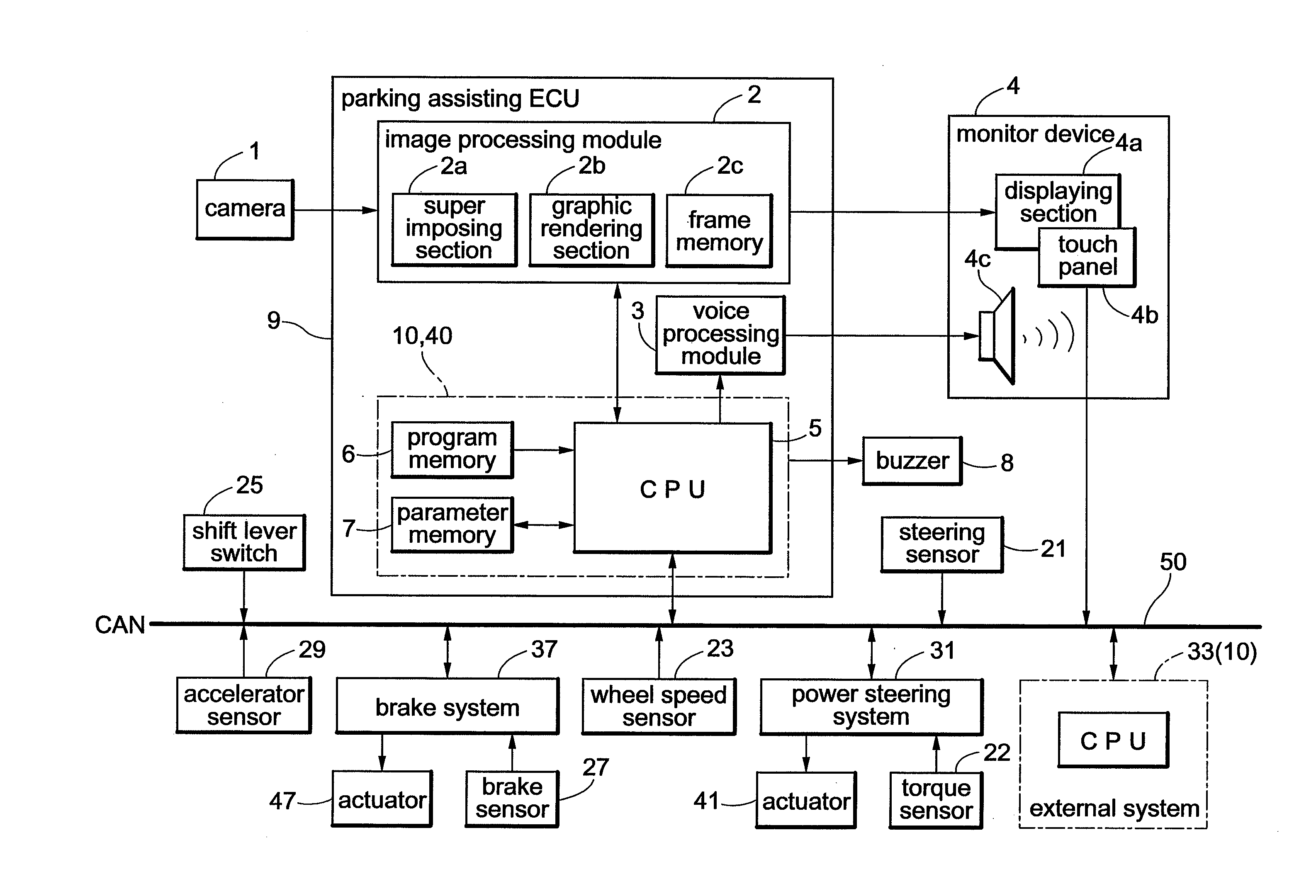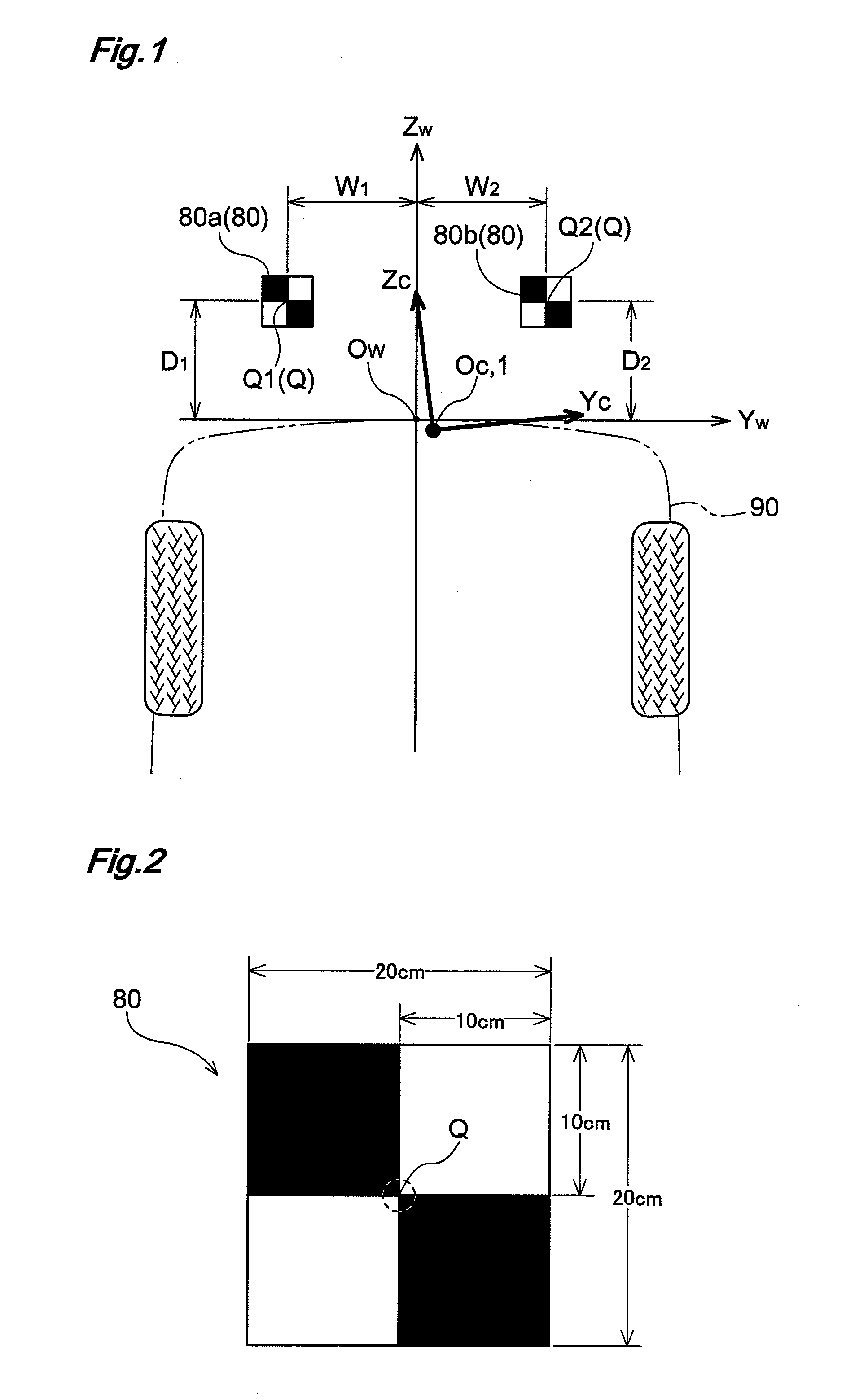[0007]Therefore, there is a need for a calibrating apparatus for an on-board camera of a vehicle, which apparatus allows speedy, yet reliable decision of acceptance / rejection of calibration result, with a simple apparatus construction.
[0014]With the above construction, the image
processing target region on which the image
processing is to be effected for detecting the calibration point in the captured image is displayed as a region frame in the form of a graphic image as being superposed on the captured image. When e.g. the calibration marker is out of the region frame, no image processing will be effected based on this calibration marker, so there is increased likelihood of inability of the calibration point detection. Therefore, even if the automatic adjustment is continued, the adjustment may not be completed properly. The worker can easily confirm visually whether the calibration marker is at a significantly deviated position or not. So, the worker can learn at an early stage of the adjustment, the likelihood of the automatic adjustment being not properly completed. In such case, there is such possibility of an error in the mounting of the on-board camera, the position of the vehicle being not appropriate, the position of the calibration marker being displaced, etc. All such cases are in' favorable for precision calibration. The worker can effect some measure such as earlier interruption or stopping of the automatic adjustment, to cope with such situation, timely and speedily through his / her visual confirmation using the region frame. That is, according to the above construction, rather than the full-automatic calibration, a “semi-automatic calibration” including a worker's visual confirmation in the course of execution of the automatic calibration can be realized in a rational manner. Incidentally, it is to be noted that a further arrangement of the worker's visually confirming the result of adjustment after completion of automatic adjustment is another conceivable mode of the above-described “semi-automatic calibration”. In such case, it will be inefficient, thus being detrimental to the productivity, if the automatic adjustment is allowed to continue even when the likelihood of failure of the automatic adjustment is so obvious. In this regard, according to the inventive construction described above, such
high likelihood of failure of the automatic adjustment can be readily recognized by the worker at an earlier stage by the worker, so the work efficiency will be improved. In this way, with the characterizing feature of the present invention, it has become possible to provide a calibrating apparatus for an on-board camera of a vehicle, which allows speedy, yet reliable decision of acceptance / rejection of calibration result, with a simple apparatus construction, without depending on or being influenced by the calibration environment.
[0024]With the above-described construction, based upon initial coordinates which are the coordinates of the calibration point when the camera coordinate system and the reference coordinate system satisfy an ideal relationship with each other, the region where the calibration markers are distributed on the captured image when the on-board camera has rotated by a predetermined angle is set as the “calibration marker distribution region”. And, this calibration marker distribution region is displayed as a region frame in the form of a graphic image, with the calibration marker distribution region being superposed on the captured image. When e.g. a calibration marker is out of the region frame, by his / her visual confirmation of this, the worker can recognize that this indicates high possibility of the on-board camera being mounted on the vehicle with excessive rotation beyond a predetermined angle, or the position of the vehicle being inappropriate. In such case due to the significant deviation between the ideal camera coordinate system and the actual camera coordinate system, even if the automatic adjustment is continued, the adjustment may not be completed properly. The worker can learn at an early stage of the adjustment, the likelihood of the automatic adjustment being not properly completed by relationship of position the region frame and the calibration markers. In such case, the worker can effect some measure such as earlier interruption or stopping of the automatic adjustment, to cope with such situation, timely and speedily. In this way, with the above characterizing feature of the present invention, it has become possible to provide a calibrating apparatus for an on-board camera of a vehicle, which allows speedy, yet reliable decision of acceptance / rejection of calibration result, with a simple apparatus construction, without depending on or being influenced by the calibration environment.
 Login to View More
Login to View More  Login to View More
Login to View More 


